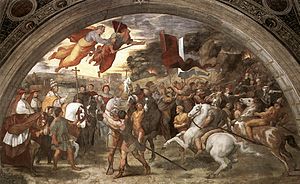Leo I the Great
Leo I the Great or the Great (Tuscany, c. 390-Rome, November 10, 461) was the 45th Pope of the Church Catholic, from 440 to 461. Pope Benedict XVI said that Leo's papacy "was without doubt one of the most important in the history of the Church."
Leo was an aristocratic Roman, and was the first Pope to be called "the Great". He is perhaps best known for having met Attila the Hun in 452 and convinced him to back down from his invasion of Italy. He is also a Doctor of the Church, best remembered theologically for publishing Flavian's Tome, a document that was an important basis for the discussions at the Council of Chalcedon, the fourth ecumenical council. That meeting dealt primarily with Christology and clarified the orthodox definition of Christ's being as the hypostatic union of two natures, divine and human, united in one person, "without confusion or division." It was followed by a major schism associated with Monophysitism, Miaphysitism, and Diophysitism. It also contributed significantly to the development of ideas on papal authority.
Biography
First of the three popes nicknamed "The Great", Leo was the son of Quintianus and the oldest historical data place him as a deacon in Rome under the pontificate of Celestine I becoming a prominent diplomat with Pope Sixtus III who, after At the request of Emperor Valentinian III, he sent him to Gaul with the mission of resolving the confrontation between Aecio, the military commander of the province, and the magistrate Albino.
León was on this mission when, after the death of Pope Sixtus III, on July 19, 440, he learned of his election as the new pontiff. He then goes to Rome where he is consecrated on September 29.
He successfully combated, through the celebration of several councils, the Manichaeism that had spread from Africa to Italy, the Pelagianism that had reappeared in Aquileia, and the Priscilianism that was maintained in Spain.
During his pontificate, the Council of Chalcedon was held in 451, which proclaimed the divinity and humanity of Christ, "consubstantial with the Father by his divinity, consubstantial with us by his humanity". Faced with the affirmations of the heresies that maintained the separation between the Father and the Son, considered inferior to the Father, Leo restored the orthodox tradition in his famous dogmatic letter to Flavian, Tomus Leonis, and which was approved by the council with the words: "Peter has spoken through Leo".
The best-known episode of his pontificate was his meeting, in 452 in the city of Mantua, with Attila, the king of the Huns, who had invaded northern Italy, forcing Emperor Valentinian III to abandon the court of Ravenna and take refuge in Rome.
León convinces Attila not to march on Rome, achieving the withdrawal of his army after signing a peace treaty with the Roman Empire in exchange for the payment of a tribute. Another shuffled theory (and not incompatible) is that Attila withdrew from Italy due to the famine and epidemics that his army suffered.
This fact had a great symbolic importance since, although the Roman Empire would continue to exist until 476, it placed the Church and not the Empire as the main political force in Europe.
A few years later, in 455, in a similar situation, the Vandals of Genseric sacked Rome, but the pope managed to ensure that the lives of its inhabitants were spared and that it was not set on fire.
As pope, he assumed the title of pontifex maximus, which had been abandoned by Roman emperors since 382.
After his death, he was buried in the vestibule of Old St. Peter's Basilica. In 688, Pope Sergius I had the body moved into the basilica and an altar erected for it; according to Gregorovius, he was the first pontiff deposed inside the basilica. Currently the remains of Leon are in the current Basilica of San Pedro, under the altar of the chapel of the Madonna della Colonna, dedicated to him, where they were transferred in 1715.
He was proclaimed a Doctor of the Church on October 15, 1754 by Benedict XIV. In the West his feast day is celebrated on November 10, the day of his death in 461.
Contenido relacionado
Leon Cathedral
Edict of faith
John Needham
Fra Angelico
Saint George

